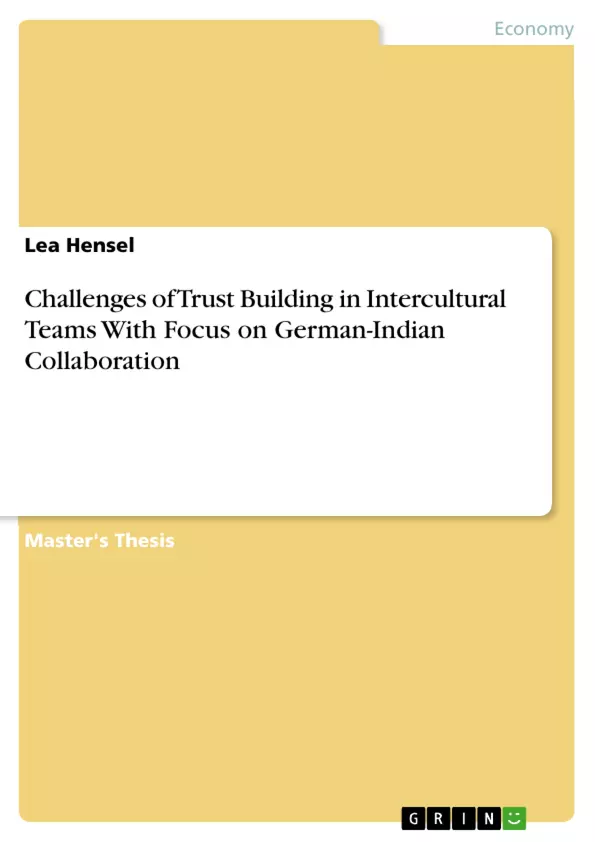Based on the existing literature and an empirical study conducted with 15 German managers, this work derived 22 trust factors that are important for the development of trust between German managers and Indian colleagues or business partners. The results show that, there is a vast variety of trust factors that need to be considered.
Additionally, the results show that cultural differences can lead to trust misunderstandings, initiated by different interpretation and diagnosis of behavior. Afterwards, recommendations for action were derived from the research findings. With this work, German managers are able to acquire knowledge about the Indian business culture, trust factors that are important in the development of trust between Germans and Indians and how they can understand, prevent or dissolve cultural misunderstandings.
Today’s business world is global, complex, dynamic, highly competitive and extremely volatile. This has increased the importance of internationalization strategies for companies in order to be competitive. In recent years, the interest for emerging markets has increased due to the size of the markets and the amount of customers, as well as the technology and human resources available.
India has grown to one of the world's leading exporters of computer software and is an attractive country for Foreign Direct Investments (FDI). However, intercultural collaborations often fail to succeed due to cultural differences and difficulties in the process of trust building. Nonetheless, the presence of interpersonal trust is highly important to successfully manage the increase in complexity and uncertainty of today’s business environment.
Inhaltsverzeichnis (Table of Contents)
- Abstract
- 1. Introduction
- Introduction and Problem Definition
- Motivation and Objective
- Methodology and Structure
- 2. Explanation of Terms
- Trust
- Culture
- 3. Theoretical Background on trust in intercultural collaboration
- Fundamental aspects of intercultural influences on trust
- Trust misunderstanding
- 4. Theoretical framework to describe the Indian business culture
- 5. Business Culture in India
- History and background about business in India
- Leadership
- Relationships
- Communication
- Tradition
- Ethical Values in Business
- 6. Empirical Part: The Study
- Research Design
- Research Issue and Objective
- Critical Incident Methodology
- Critical reflection of the methodology
- Sampling and conducting the study
- Selection criteria and process for study participants
- Planning and conducting the interviews
- Data Collection Methodology
- Recruitment of interview partner and interview procedure
- Specification of sampling and data material
- Representativeness of the sampling
- Evaluation Methodology
- Short discussion of the German business culture
- Definition of trust factors and overview
- Detailed discussion of the trust factors identified
- Interpersonal Relationship
- Hierarchy
- Fair Play
- Handling of Agreements and Tasks
- Communication
- Environment
- Research Design
- 7. Results and Discussion
- 8. Recommendations for action
Zielsetzung und Themenschwerpunkte (Objectives and Key Themes)
This master's thesis examines the challenges of building trust in intercultural teams, using the example of German-Indian collaboration. It investigates the factors that influence trust development in this context and explores potential cultural misunderstandings that arise. The work aims to provide practical recommendations for German managers working with Indian colleagues or business partners.
- Intercultural trust building in German-Indian teams
- Impact of cultural differences on trust development
- Identification of key trust factors in intercultural collaboration
- Analysis of cultural misunderstandings and their implications
- Recommendations for fostering trust and managing cultural diversity in international teams
Zusammenfassung der Kapitel (Chapter Summaries)
- Chapter 1: Introduction This chapter introduces the topic of intercultural trust building in the context of German-Indian collaboration. It outlines the problem definition, the motivation behind the research, and the research methodology. It also details the structure of the thesis.
- Chapter 2: Explanation of Terms This chapter defines the key terms that are central to the thesis, namely "trust" and "culture." It provides a theoretical foundation for understanding these concepts in the context of intercultural collaboration.
- Chapter 3: Theoretical Background on trust in intercultural collaboration This chapter explores the theoretical framework for understanding the impact of intercultural influences on trust development. It delves into the concept of trust misunderstanding and its significance in intercultural collaboration.
- Chapter 4: Theoretical framework to describe the Indian business culture This chapter presents a theoretical framework for understanding the Indian business culture, providing a foundation for the analysis of trust factors in the context of German-Indian collaboration.
- Chapter 5: Business Culture in India This chapter provides an overview of the Indian business culture, exploring its history, leadership styles, relationship dynamics, communication practices, traditional values, and ethical considerations in business.
- Chapter 6: Empirical Part: The Study This chapter details the research design and methodology used to conduct the empirical study. It outlines the research issue and objective, the methodology employed (Critical Incident Methodology), and the sampling and data collection procedures.
- Chapter 7: Results and Discussion This chapter presents the results of the empirical study, analyzing the identified trust factors and discussing their implications for intercultural trust building in German-Indian teams. The chapter also explores potential cultural misunderstandings and their impact on trust.
Schlüsselwörter (Keywords)
The key focus of this master's thesis lies in understanding the complexities of trust building in intercultural teams, particularly between German and Indian collaborators. The work explores the influence of cultural differences on trust development, analyzing key trust factors and identifying potential misunderstandings that arise. The study investigates the Indian business culture and draws upon empirical research findings to provide practical recommendations for German managers working with Indian colleagues or business partners.
- Arbeit zitieren
- Lea Hensel (Autor:in), 2019, Challenges of Trust Building in Intercultural Teams With Focus on German-Indian Collaboration, München, GRIN Verlag, https://www.grin.com/document/496169



